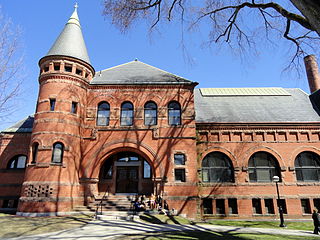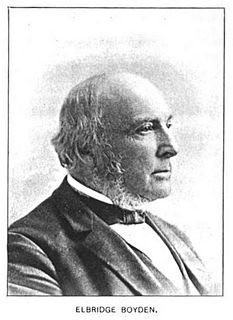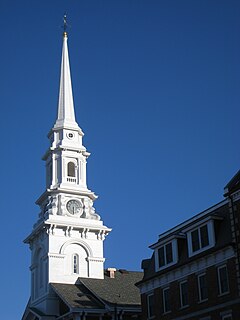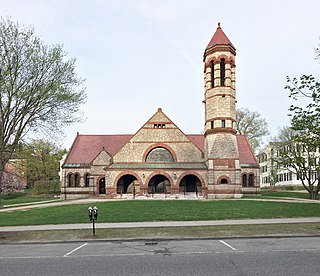
Samuel J. F. Thayer (1842–1893) was an American architect, notable for designing buildings such as the Providence City Hall and the Cathedral of St. George, as well as the town halls of Brookline, Stoughton, and Methuen, Massachusetts.

Charles Kirk Kirby, was an American architect who practiced in Massachusetts, Maine, and California.

Hartwell and Richardson was a Boston, Massachusetts architectural firm established in 1881, by Henry Walker Hartwell (1833–1919) and William Cummings Richardson (1854–1935). The firm contributed significantly to the current building stock and architecture of the greater Boston area. Many of its buildings are listed on the National Register of Historic Places.

James Murphy, FAIA, (1834–1907) was an Irish-American architect active in late-nineteenth- and early twentieth-century New England, who designed numerous Roman Catholic churches and related structures. He was a Fellow of the American Institute of Architects.

Elbridge Boyden (1810–1898) was a prominent 19th-century American architect from Worcester, Massachusetts who designed numerous civil and public buildings throughout New England and other parts of the United States. Perhaps his best known works are the Taunton State Hospital (1851) and Mechanics Hall (1855) in Worcester.

Shepard S. Woodcock (1824-1910) was an American architect practicing in Boston, Massachusetts during the second half of the nineteenth century.
William R. Walker & Son was an American architectural firm in Providence, Rhode Island, active during the years 1881 to 1938. It included partners William Russell Walker (1830–1905), William Howard Walker (1865–1922), and later, William Russell Walker II (1889–1936).

George F. Loring (1851-1918) was an architect from Boston, Massachusetts.

Robert Charles Nicholson Monahan was a Canadian-American architect from Pawtucket, Rhode Island.

Richard Bond (1798–1861) was an early American architect who practiced primarily in Boston, Massachusetts.

Charles Edward Parker (1826-1890) was an American architect from Boston, Massachusetts.

Waldo V. Howard was an American architect practicing in the city of Brockton, Massachusetts and its suburbs.

John D. Towle was an American architect.

C. Willis Damon (1850-1916) was an American architect from Haverhill, Massachusetts.

Amos Porter Cutting (1839–1896) was an American architect from Worcester, Massachusetts.

George G. Adams was an American architect from Lawrence, Massachusetts.

William R. Walker was an American architect from Providence, Rhode Island, who was later the senior partner of William R. Walker & Son.

John Ashton (1860-1953) was an American architect from Lawrence, Massachusetts.

John Lyman Faxon (1851-1918) was an American architect practicing in Boston, Massachusetts, during the late nineteenth and early twentieth centuries. Three of his buildings, the First Baptist Church of Newton (1888), the First Congregational Church of Detroit (1889-91) and the former East Boston High School (1898-1901), have been listed on the United States National Register of Historic Places.

Eugene C. Gardner (1836–1915) was an American architect and author of Springfield, Massachusetts. Gardner was noted both for the architectural influence of his extensive practice as well as his writings on the American home. Gardner was the most notable architect of Springfield.




















